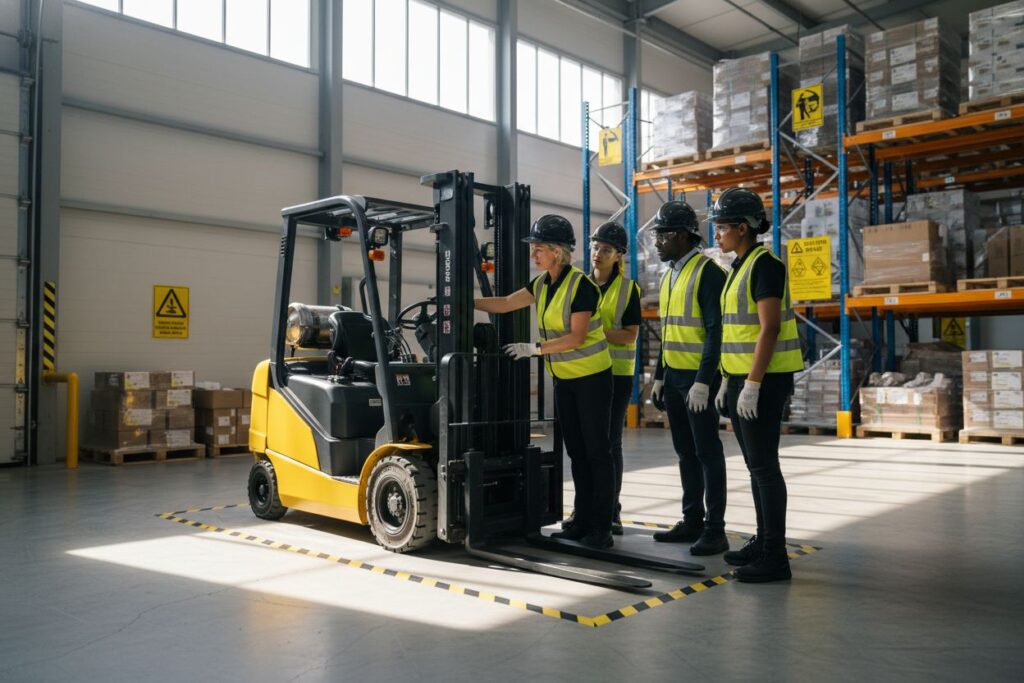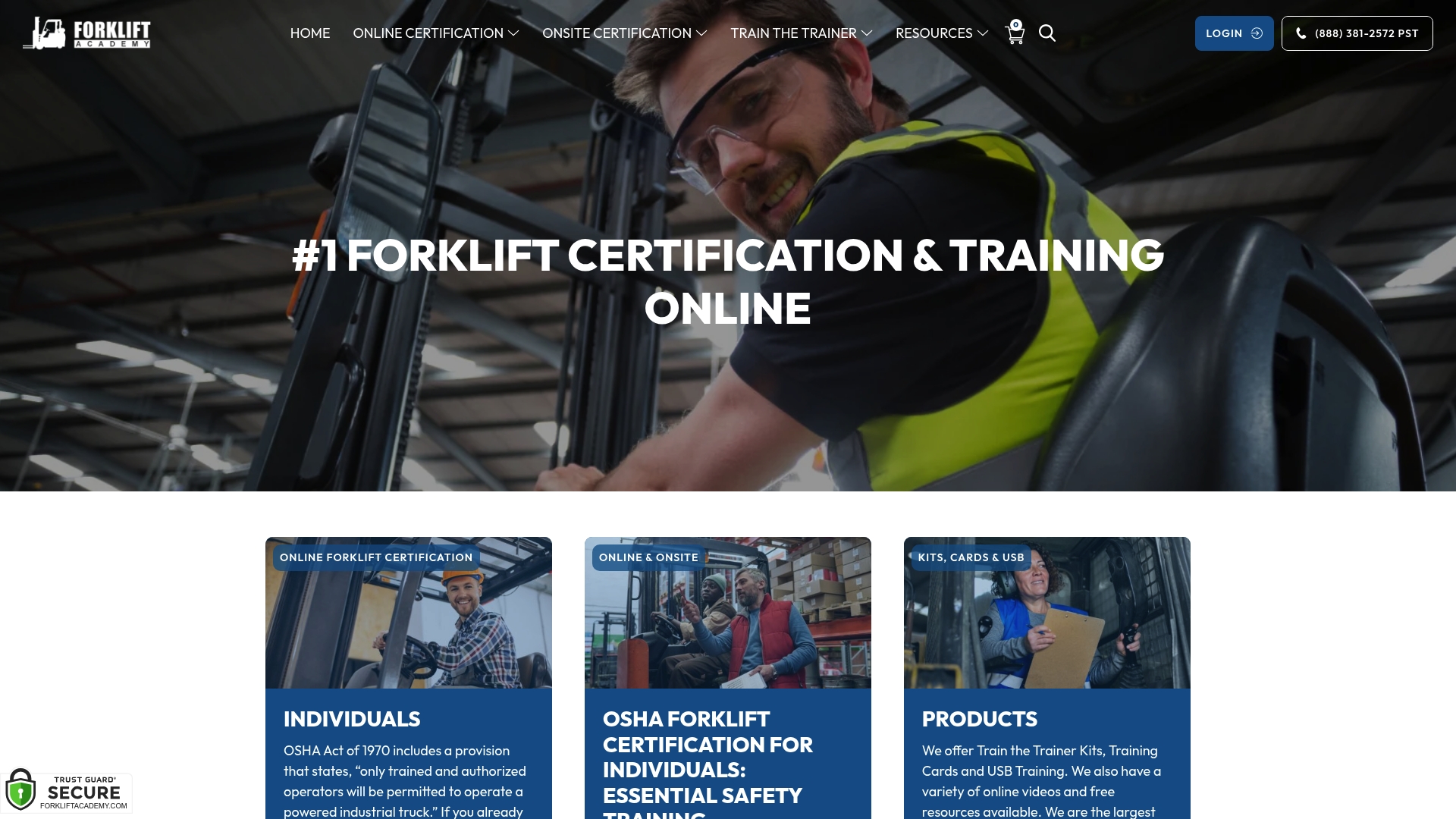
Did you know that forklift accidents result in more than 34,000 serious injuries each year in the United States? For anyone working around heavy equipment, safety training is as vital as any tool on the job. Understanding forklift certification, proper training methods, key operational practices, and ongoing maintenance helps protect everyone while preventing costly mistakes. Gaining the right knowledge transforms everyday forklift use into a foundation for safer, more efficient workplaces.
| Takeaway | Explanation |
|---|---|
| 1. Only certified operators may operate forklifts. | OSHA regulations require formal training and certification for all forklift operators to ensure safety and compliance. |
| 2. Training includes formal instruction, practical demo, and evaluation. | A comprehensive training approach ensures operators understand both theory and practice, essential for safe forklift operation. |
| 3. Recertification is required every three years. | Operators must be evaluated regularly to maintain their certification, ensuring ongoing skills competency and safety adherence. |
| 4. Safety practices focus on load stability and workplace awareness. | Operators should understand the stability triangle and constantly scan their environment to avoid accidents. |
| 5. Regular inspection and maintenance are critical. | Daily checks and systematic maintenance help prevent equipment failures and safeguard operator safety in the workplace. |
Forklift operation isn’t just about driving skills. It’s about comprehensive safety training that protects workers and workplaces. OSHA’s forklift training requirements are designed to ensure every operator understands the critical responsibilities that come with handling powerful industrial equipment.
According to OSHA regulations, forklift training is not optional. Only trained and certified operators are legally permitted to operate powered industrial trucks. This means your training must go far beyond basic driving techniques. OSHA mandates a three-part training approach that covers every aspect of safe operation:
What makes OSHA’s approach unique is its performance-based training model. Your training isn’t a one-size-fits-all program. Instead, it adapts to your existing knowledge, skills, and workplace environment. Employers must document your training and conduct evaluations at least every three years.
Crucial trigger points for mandatory retraining include unsafe performance, workplace accidents, introduction of new equipment, or significant changes in workplace conditions. This dynamic approach ensures operators remain sharp, alert, and prepared for evolving workplace challenges.
Remember. Certification isn’t just a piece of paper. It’s your passport to safe, professional forklift operation and your first line of defense against potential workplace incidents.
When it comes to forklift certification, you have two primary pathways: online training and onsite instruction. Both methods have unique advantages that can significantly impact your learning experience and professional development. Understanding the online certification options helps you make an informed decision about your training approach.
Online training offers unprecedented flexibility and convenience. You can access standardized curriculum from anywhere with internet connectivity, learn at your own pace, and review materials multiple times. Key benefits of online certification include:
Onsite training, by contrast, provides a more interactive and hands on learning environment. Professional instructors can provide immediate feedback, demonstrate complex techniques in real time, and assess your practical skills directly. In person training creates opportunities for:
Research indicates online training ensures consistent instruction across different locations. However, it might lack the personal interaction and physical practice that onsite training delivers. The most effective approach often combines both methods to maximize learning outcomes.
Your specific workplace requirements, learning style, and schedule will ultimately determine which certification path works best for you. Some employers prefer or require in person training, while others accept comprehensive online programs. Always confirm certification requirements with your specific employer or industry sector before selecting your training method.
Safety isn’t just a checklist. It’s the core of professional forklift operation. Knowing the top safety practices can literally save lives and prevent costly workplace accidents.
Forklift stability is the foundation of safe operation. Understanding how your machine maintains balance requires mastering the complex relationship between load weight, truck configuration, and environmental conditions. OSHA emphasizes that operators must comprehend the stability triangle concept. This geometric principle explains how forklifts remain upright during movement.
Critical safety practices include:
Workplace awareness goes beyond machine mechanics. You must constantly scan your environment for potential hazards. This means understanding visibility challenges, anticipating pedestrian movement, and navigating complex spaces like narrow aisles and ramped surfaces.
Practical load management is your primary safety strategy. Never exceed your forklift’s rated capacity. Always assess load stability before lifting. Unbalanced or improperly secured loads can cause catastrophic tip overs. Your job is to think several steps ahead and predict potential risks.
Remember that smooth, deliberate movements are safer than quick reactions. Sudden stops, sharp turns, and aggressive acceleration dramatically increase accident potential. Treat your forklift like a precision instrument requiring finesse and constant attention.
A well-maintained forklift isn’t just a machine. It’s your lifeline in the workplace. Understanding equipment maintenance fundamentals can prevent costly breakdowns and potentially life threatening accidents.
Routine inspection is the cornerstone of forklift safety. Professional operators know that maintenance isn’t a sporadic task but a systematic approach to equipment management. Experts recommend a multilayered inspection strategy that breaks down maintenance into clear intervals and specific focus areas.
Your maintenance protocol should include:
Critical inspection points demand your careful attention. Key areas to examine include:
Qualified personnel should perform these inspections following manufacturer guidelines. Documentation is not optional. Maintaining precise records of each inspection creates accountability and helps track your equipment’s long term health.
Remember that preventative maintenance is always more cost effective than emergency repairs. A few minutes of careful inspection can save hours of potential downtime and prevent workplace accidents. Your commitment to thorough equipment maintenance reflects your professionalism and commitment to workplace safety.
Forklift operation transforms you from a simple driver to a precision engineer of weight and motion. Understanding load handling principles is not just a skill. It’s an art form that combines physics, spatial awareness, and calculated risk management.
The stability triangle is your fundamental safety framework. Think of it as an invisible geometric guardrail that determines whether your forklift remains upright or tips over. Every movement you make must keep the combined center of gravity within this delicate triangular zone.
Critical load handling principles include:
Load composition requires strategic thinking. Not all loads are created equal. A box of pillows differs dramatically from a steel beam of identical weight. Factors like weight distribution, package shape, and balance dramatically impact your handling approach.
Workplace conditions add another layer of complexity. Uneven surfaces, tight corners, and sloped environments transform simple load handling into a high stakes balancing act. Your job is to anticipate potential shifts and adjust your technique accordingly.
Remember. Overconfidence kills more operators than technical ignorance. Treat every load with respect. Move deliberately. Think three steps ahead. Your precision can prevent accidents that might otherwise result in serious injury or equipment damage.
Mastering forklift controls is like learning a complex dance between human precision and mechanical power. Understanding advanced operating techniques transforms you from a basic operator to a true workplace professional.
Control mastery begins with understanding your machine’s fundamental language. Each lever, pedal, and switch communicates critical information about your forklift’s current state and potential movements. Operators must develop an almost intuitive connection with their equipment.
Critical control principles include:
Maneuvering requires anticipation and calculated movements. Your job is to predict potential challenges before they emerge. This means understanding how your forklift responds in different workplace environments challenging surfaces, tight corners, and varying load weights.
Specific maneuver techniques dramatically improve safety:
Operators must recognize their visibility limitations. Unlike passenger vehicles, forklifts have significant blind spots. Your spatial awareness becomes your most critical safety tool. Always assume someone might be in your path and move accordingly.
Remember. Precision trumps speed. Every control input should be deliberate. Your goal isn’t just to move materials. Your goal is to move materials safely and professionally.
Your forklift certification isn’t a one time achievement. It’s an ongoing commitment to professional excellence and workplace safety. Understanding the nuances of recertification ensures you remain a top tier operator throughout your career.
OSHA mandates a comprehensive evaluation process that goes far beyond simple paperwork. Your employer must track your performance meticulously, documenting not just your initial training but your continued competence and safety record.
Key recertification triggers include:
Performance documentation is critical. Your certification record must include specific details:
Recertification isn’t a punitive process. It’s an opportunity to refine your skills, learn from past experiences, and demonstrate your commitment to continuous improvement. Think of it as professional development disguised as a safety protocol.
Remember. Your certification is a living document. Stay proactive. Seek feedback. Practice consistently. Your dedication to ongoing learning separates professional operators from merely competent ones.
Below is a comprehensive table summarizing OSHA forklift training requirements, certification options, safety practices, maintenance protocols, and evaluation essentials highlighted in the article.
| Topic | Description | Key Points/Considerations |
|---|---|---|
| OSHA Forklift Training | Mandatory performance-based training for operators. | Includes formal instruction, practical demonstrations, and workplace evaluation. Certified every 3 years. |
| Certification Options | Online and onsite certification pathways. | Online is flexible & cost-effective; onsite offers hands-on experience. Best approach often combines both methods. |
| Key Safety Practices | Critical for preventing accidents. | Stability triangle, load management, and environmental awareness crucial. |
| Equipment Maintenance | Ensures safe and efficient operation. | Regular inspections, with detailed checks on critical components like hydraulic hoses and brakes. |
| Load Handling Principles | Integrates physics and spatial awareness for safe operations. | Maintain loads low, avoid sudden movements, and respect forklift capacity. |
| Forklift Controls | Requires precision and knowledge. | Develop intuitive connection with equipment for safe maneuvering. |
| Evaluation Essentials | Certification is ongoing, requiring regular updates. | Triggered by unsafe behaviors, new equipment, or workplace changes. Documented thoroughly. |
Do you find it tough keeping up with OSHA’s strict training requirements and real workplace safety demands? Every point in our “7 Forklift Training Essentials Every Operator Must Know” article touches on a real pain: confusing certification rules, record-keeping stress, and the daily risks of unsafe practices. Operators face tough challenges like learning the stability triangle, keeping up with recertification cycles, and making sure every load is handled with care. These are not just rules on paper. They directly affect job security and workplace safety for you and your team. If you want to stay ahead, you need a training partner that’s built for you. See our Forklift Safety resources for deeper insights and proven techniques that reduce risk and boost confidence on the job.

Don’t settle for outdated training or guesswork. Visit Forkliftacademy.com today to access flexible forklift certification options that fit your schedule and learning style. Get OSHA compliant, keep your skills sharp, and secure your professional future now. Time is critical. Safe operators are always in demand. Start your path to safer, stronger forklift operation right away.
The key elements include formal instruction, practical demonstrations, and workplace evaluations. Ensure you complete all three parts to gain comprehensive training and maintain safety.
You need to be recertified every three years, barring any triggers for mandatory retraining such as unsafe performance or changes in workplace conditions. Monitor your certification status closely to ensure compliance and safety.
If you notice unsafe operational behavior, report it immediately to your supervisor. Addressing safety issues promptly helps maintain a safe work environment for everyone.
Evaluate your forklift’s maintenance needs through daily visual inspections and more thorough checks every 200 operational hours. Document each inspection to ensure accountability and track the equipment’s condition.
The stability triangle refers to the geometric zone determining your forklift’s balance while handling loads. Always keep your load’s center of gravity within this triangle to prevent tip-overs.
Ongoing training is essential because it helps operators refine skills, learn from experiences, and adapt to any new equipment or workplace conditions. Stay proactive and seek regular feedback to maintain high safety standards.